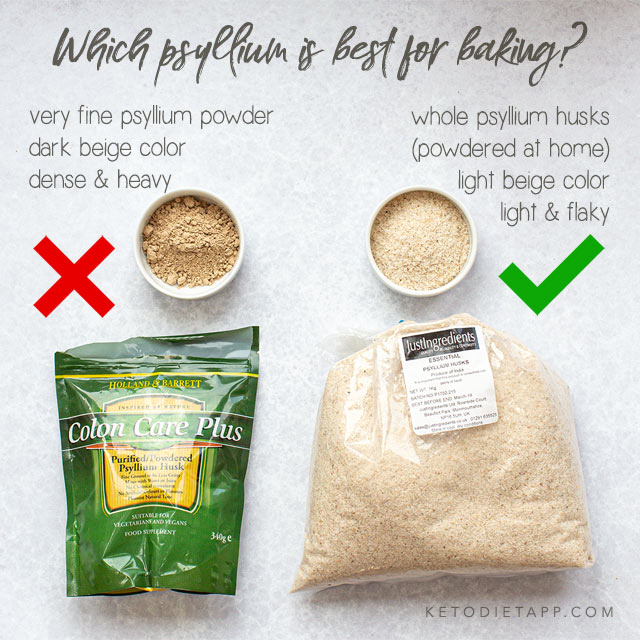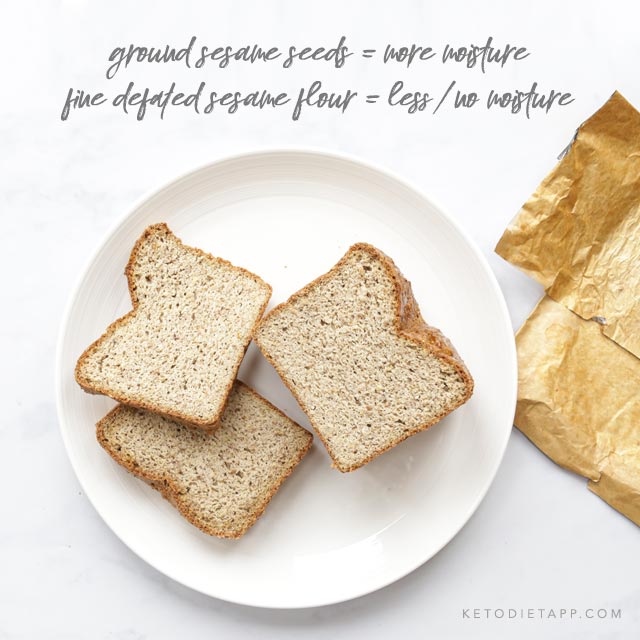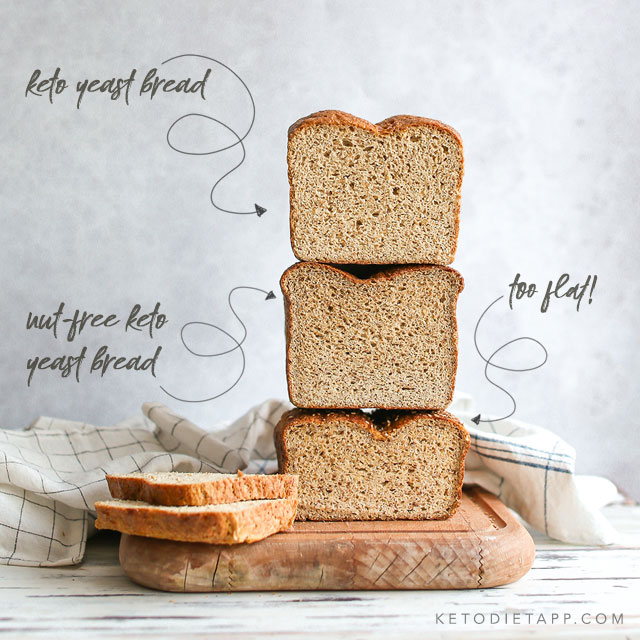Fluffy low-carb yeast bread has been on my to-do list forever and I knew I had to make it keto. I finally have the perfect low-carb and keto yeast bread recipe and I am so excited to share with you!
I'll admit I took my time to get this done. I first made this low-carb yeast bread recipe in summer 2019 but I wanted to make a few adjustments and try a few more baking mixes before I was 100% happy with the results. Life gets busy, I signed two new books and before I knew six months have passed.
How to Make Keto Yeast Bread
Making low-carb yeast bread is easier than you may think. I already knew how to make Low-Carb Bread so I used the same recipe to start with and combined it with what I've learnt about yeast and how to use it in baking to get the best results.
Having tested many loaves of bread, I have one piece of advice for you: If you don't have to use any substitutions, follow the recipe as it is with no swaps, especially when it comes to using defatted sesame flour. I tested several substitutions and nothing compared to the original recipe which had the best taste and texture.
Here's what you'll need to make keto yeast bread:
- Dry active yeast. This ingredient will make your bread fluffy and will add a delicious flavour to it. You will need to use warm water to activate the yeast. The ideal temperature should be about 40 °C/ 100 °F.
- Inulin-based sweetener such as yacon syrup or sugar. This ingredient is essential for activating the yeast. Don't panic, no sugar will be left after the fermentation of yeast!
- Eggs and egg whites. You'll generally need to use more egg whites to keep the bread fluffy. Don't worry it won't taste eggy!
- Apple cider vinegar. This ingredient will add a fantastic flavour to your bread. Plus, when combined with baking soda, it acts as a leavening agent.
- Ground nuts and/or seeds. I like the combination of flax meal and sesame flour because they work perfectly in a bread recipe. Not too overpowering so you can still eat this bread with sweet spreads like chia jam and other tasty toppings like Keto Nutella.
- Coconut flour. Great for texture and it tastes neutral when used in small amounts together with other nut and seed flours. I promise, you won't taste any coconut. If you still want to avoid it you can use the same amount (in cups) of flax meal or sesame flour, or about three times more almond flour.
- Psyllium husks, powdered. This ingredient is absolutely essential if you want to get the perfect fluffy texture. Check out my tips below to learn why I use whole husks rather than ready-made powder.
- Whey protein isolate powder or egg white protein isolate powder to replace the missing gluten.
- Leavening agents including gluten-free baking powder, or a combination of cream of tartar and baking soda. To get 1 teaspoon of gluten-free baking powder, simply use 1/2 tsp cream of tartar and 1/4 tsp baking soda.
- Other ingredients. Depending on the flavour you want to achieve you can add salt, pepper, sesame seeds, herbs, spices, garlic powder or onion powder. Whatever you fancy!
Why Use Yeast in Keto Bread?
Yeast is a single-celled fungus that works by feeding on sugar and in return excretes carbon dioxide and alcohol as by-products.
This fermentation process of yeast makes dough rise and allows it to become light and fluffy by creating air pockets inside. Apart from its role as a leavening agent, yeast adds a delicious flavour to any bread.
We're working with gluten-free ingredients so the effect won't be exactly the same as you would expect in a traditional yeast bread. Plus there is fat in seeds, nuts and coconut which makes any keto bread naturally less fluffy. Still this recipe is by far my favourite way to make low-carb and keto bread that is fluffy and tastes amazing.
To replace the missing gluten, we are using powdered psyllium husks and whey or egg white protein isolate powder. These two ingredients are essential for the texture of almost any keto bread.
Make sure to use dry active yeast or fresh yeast. Do not use nutritional yeast as that would not work in this recipe.
If the yeast does not activate (does not become frothy), do not use it because the yeast is not active. This can happen if the yeast is not properly stored or is old.
Can I Use Fast-Acting Dried Yeast?
Yes, you cab use instant yeast which is also known as fast-acting or fast-rising yeast. You won't need to activate is and can mix it directly with the dry ingredients. Do not reduce the amount of water used in the recipe.
What if My Yeast Doesn't Foam?
If your yeast doesn't foam it meant it's not activated and the fermentation didn't start. This can happen when:
- The water was too hot or it was too cold. When working with yeast, make sure you get the temperature right. The ideal temperature is about 40 °C/ 100 °F. Too hot and the yeast will not survive. Too cold and the yeast will remain dormant. You don't have to use a thermometer though — you can simply use your finger to test the water. If it feels hot, it will likely be too hot for your yeast to survive.
- The yeast expired. Yeast will expire because it's a fungus that eventually dies. If the yeast is foaming it means it's still alive and will be fine to use. The expiry date will give you a good estimate of how long the yeast will last, but various conditions, such as where and how yeast is stored, will affect how long it will live.
- You used a sweetener that doesn't work with yeast. You'll need inulin-based sweetener such as yacon syrup, or nutritive sweeteners such as maple syrup, honey, coconut sugar or even sugar. (Don't panic, no sugar will be left after the fermentation of yeast!) Do not use low-carb sweeteners like Erythritol, Swerve, Allulose or Xylitol to activate the yeast as these options won't work.
Can I Use Carton Egg Whites?
Yes, you can use carton eg whites instead or fresh egg whites. The recipe uses large egg whites and you should be counting each egg white as 33 grams (1.2 oz). Make sure to use a kitchen scale to measure them accurately.
I'm Keto, Can I Really Use Sugar?
Yes, you can! No carbs form sugar or yacon syrup will be left in the bread because it will be consumed by the yeast. I don't have sugar in my house so I used yacon syrup which works just as well.
When working with yeast, make sure you get the temperature right. The ideal temperature is about 40 °C/ 100 °F. Too hot and the yeast will not survive. Too cold and the yeast will remain dormant. You don't have to use a thermometer though — you can simply use your finger to test the water. If it feels hot, it will likely be too hot for your yeast to survive.
Apart from sugar and yacon syrup, you can use other nutritive sweeteners such as coconut sugar, maple syrup or honey. Do not use non-nutritive sweeteners such as Erythritol, Swerve or stevia as these won't work.
Can I Use Psyllium Husk Powder?
I don't recommend ready-made psyllium husk powder. I've baked dozens of keto breads and I made all of them using whole psyllium husks that I powdered myself. Ready-made psyllium husk powder is often too fine and makes any keto bread too dense, flat and heavy. Sometimes the bread would also get a purple hue and an ammonia-like aftertaste (although that may be related to rancid flax meal). Trust me, you don't want any of these in your low-carb bread!
The best way to get the best texture and flavour is to buy whole psyllium husks and powder them in a coffee grinder of a food processor.
 Follow us 148.4k
Follow us 148.4k
Do I Need to Use Protein Powder?
We are using protein powder to replace the gluten that is missing in a low-carb bread. If you don't use it, your keto bread may not be as fluffy but it will be just as delicious.
Some keto recipes also ask for xanthan gum as it works perfectly in gluten-free bread recipes. It will make the dough more elastic, just like gluten does. However, beware that xanthan gum ma cause digestive issues so keep that in mind if you are considering it. If you want to use xanthan gum, simply skip the protein powder and use a teaspoon of xanthan gum instead.
Does This Keto Bread Taste Eggy?
Not at all! Unlike some low-carb bread recipes you may have tried before, this bread does not taste eggy even though it uses many eggs.
We want this bread to be fluffy so we will need more egg whites and just a few egg yolks. We're also using one egg yolk to brush on to as it will help create a nice crust.
Is This Keto Bread Moist?
Compared to most other low-carb breads, I find that the moisture in this keto yeast bread is negligible. However, if you use ground sesame seeds instead of fine sesame flour, you will get a lot more moisture.
If you've made keto bread before, moisture is a common issue. The reason it's moist is not the extra eggs or water used to make the dough — on the contrary, these are both essential for texture and for the bread to rise. The ingredients responsible for moisture are psyllium and flax meal (and also ground sesame seeds as opposed to fine sesame flour) as they will lock moisture in the bread. They are both essential in keto baking as psyllium adds volume and fluffy texture, while flax meal makes the bread taste more authentic.
You could take it a step further and dehydrate the bread in the oven right after you bake it. To do that, I removed the bread from the loaf pan by grabbing the edges of the parchment paper and placed it directly on the rack in the oven. I then baked it at 100 °C/ 212 °F for about 30 minutes. Other than that, this keto yeast bread can be toasted in a toaster or under a broiler just like regular bread.
 Follow us 148.4k
Follow us 148.4k
How Many Servings Does One Recipe Make?
Depending on the size of your loaf pan and the thickness of the slices, this recipe makes 12 to 14 servings (1 slice per serving).
Should I Weigh the Ingredients?
Yes, for best results you should weigh all of the dry ingredients (apart from the ingredients that are used in small amounts such as teaspoons). I included amounts per cups but they are not the most accurate measure when it comes to low-carb baking.
Can I Substitute Defated Sesame Flour with Ground Sesame Seeds?
Yes, you can although the bread may be a bit more moist. I've had the amazing (if not the best) results with fine defated sesame flour but it is an ingredient that may not be easily available. I get mine on Amazon.
Ground sesame seeds are different from fine defated sesame flour so you can't swap them in the same ratio. They contain more fat and the texture is closer to flax meal. I've made this bread ground sesame seeds and here is what I found if you want to get the best results:
- To replace defated sesame flour with ground sesame seeds, use 1 cup packed ground sesame seeds (140 g/ 5 oz) for every 1 1/4 cups fine defated sesame flour (100 g/ 3.5 oz).
- Decrease the amount of water to a total of 1 1/2 to 1 3/4 cups (360 ml to 420 ml) or the bread may be too moist. If unsure, use less.
- Because of the higher-fat nature of sesame seeds, you could also swap the egg yolks with more egg whites. This means that for one loaf you will need a total of 8 egg whites.
- There seems to be a difference even between hulled and unhulled sesame seeds (hulled work better).
How to Make Easy Swaps
I've tried and tested many different ways to make keto yeast bread and found two winners that tasted best. The recipe I liked most also happens to be nut-free. It uses flax meal, sesame flour and coconut flour. Generally speaking you can make the following swaps:
- If you want to make this bread with almond flour instead of sesame flour, you can use about 2 cups (200 g/ 7.1 oz) of regular almond flour (ground blanched almonds, not defated almond flour). I've tested this option as you can see on the image below. Almond flour can be substituted with the same amount of ground sunflower seeds.
- Sesame flour and flax meal can be substituted with one another using approximately the same ratio (in cups).
- Fine sesame flour can be substituted with ground sesame seeds. Fine defated sesame flour is similar to defated almond flour (and can be substituted in a similar ratio), the texture of ground sesame seeds is closer to flax meal (contains more fat and will make the dough more sticky and wet).
- Coconut flour is the most absorbent of all of the options. Typically, I would use about three times more almond flour to replace coconut flour, and about twice as much of flax meal or sesame seed flour (in cups) to replace coconut flour.
Low-Carb Baking Conversions
1 cup regular almond flour = 1/3 cup coconut flour + 1 egg or egg white
1 cup regular almond flour = 1/2 cup packed flax meal or 1/2 cup packed ground sesame seeds
1 cup regular almond flour = 1 cup ground sunflower seeds
1 cup packed ground sesame seeds = 1 cup packed flax meal
1 cup fine defated sesame flour = 1 cup fine defated almond flour (plus reduce the amount of water to just 1 1/2 cups)
If you can't find defated almond flour or defated sesame flour (which are still the best options in this recipe), you can use about 2 cups of regular almond flour (see section above for more information).
Why Is my Keto Bread Hollow Inside?
If your bread is hollow inside with an air bubble (just like the one I got in this bread, try making small burger buns instead of a loaf. I listed a few possible reasons in my original keto bread guide but I'm not absolutely sure as to why this happens. What I found is that if you make smaller burger sized buns, you won't get any hollow gaps.
How Much Will My Bread Rise?
This will depend on several factors. Apart from the ingredients you use and the process you follow, even the shape and size of your bread loaf can affect the final result. On the photo below you can see that the loaf on the bottom is not as fluffy and well risen and two on top. That's the bread I made in a wider bread loaf pan and I also added the second part of the warm water too late (after all of the dry ingredients). This resulted in a less fluffy, flatter, more dense bread. It was still tasty though!
I used a 13 x 20 cm/ 5 x 8 inch loaf pan but you can use a bigger loaf pan too. Do not use silicone loaf pans as they are not sturdy enough to hold the shape of the dough and it may collapse/be dense and uneven.
Living at High Altitudes?
If you live at higher altitudes, increase your oven temperature by 15-30F and start checking the bread after 45 minutes instead of 60 minutes. Use a wooden skewer to test for doneness.
 Follow us 148.4k
Follow us 148.4k
Hands-on Overall
Serving size 1 slice
Nutritional values (per serving, 1 slice)
Net carbs1.6 grams
Protein8.7 grams
Fat5.3 grams
Calories101 kcal
Calories from carbs 7%, protein 39%, fat 54%
Total carbs6.3 gramsFiber4.7 gramsSugars0.5 gramsSaturated fat1.4 gramsSodium240 mg(10% RDA)Magnesium52 mg(13% RDA)Potassium169 mg(8% EMR)
